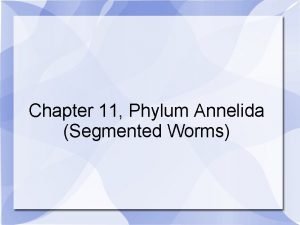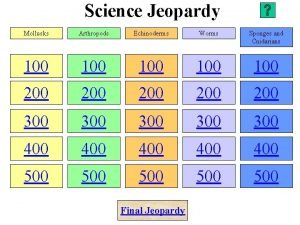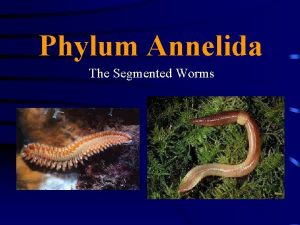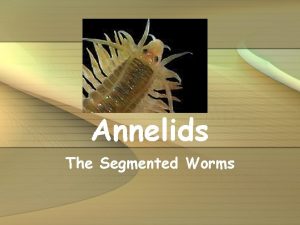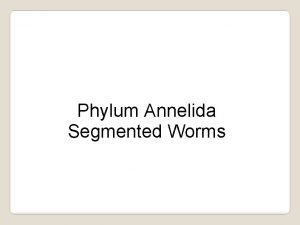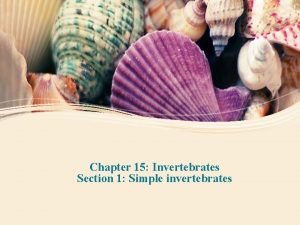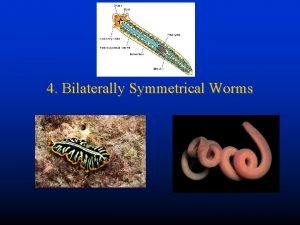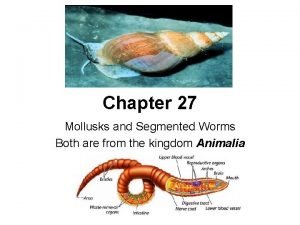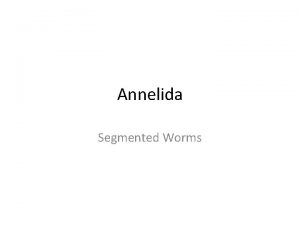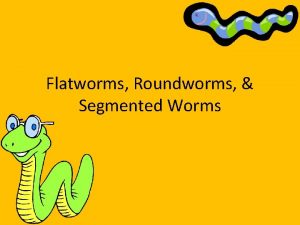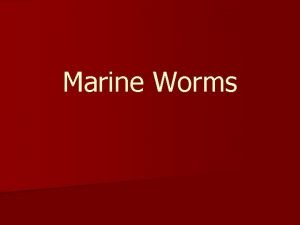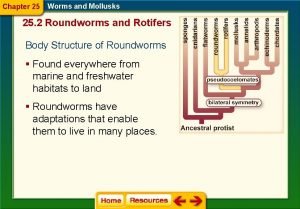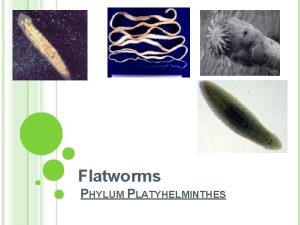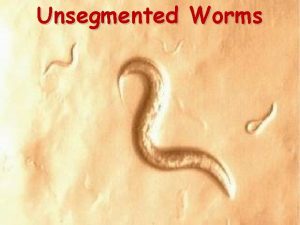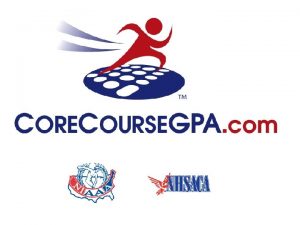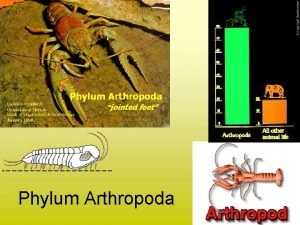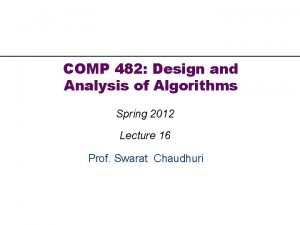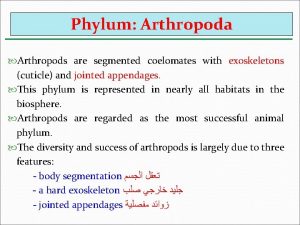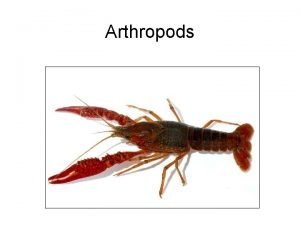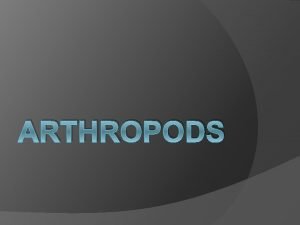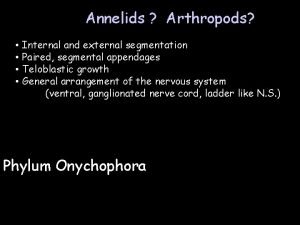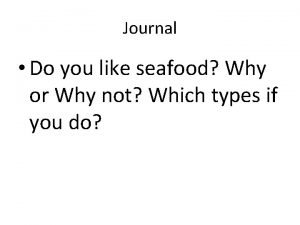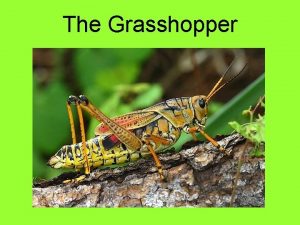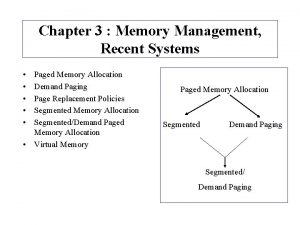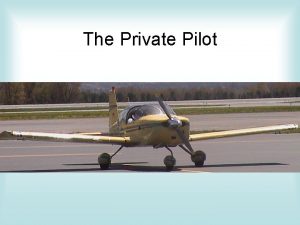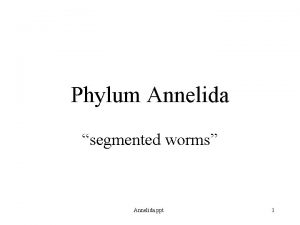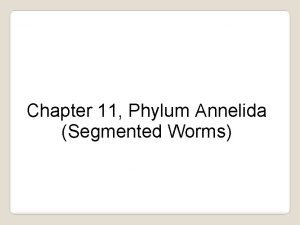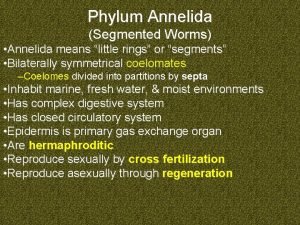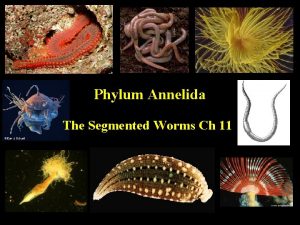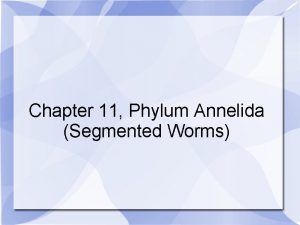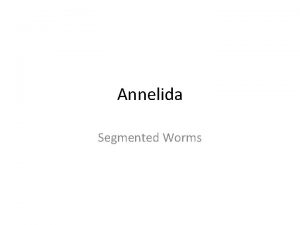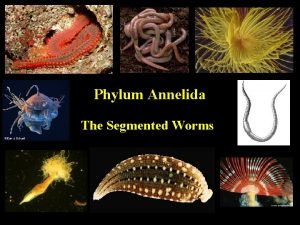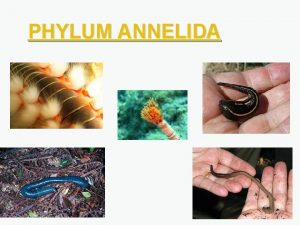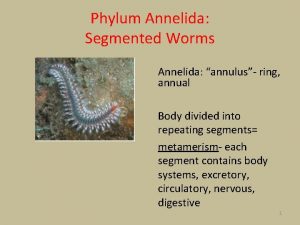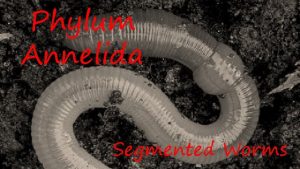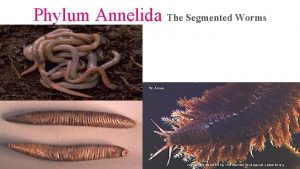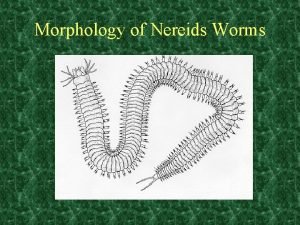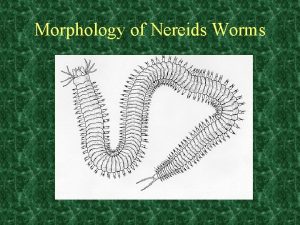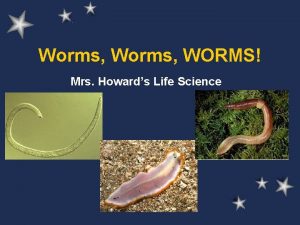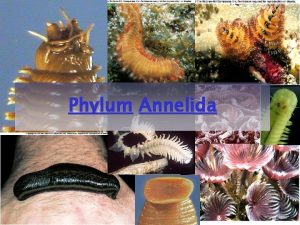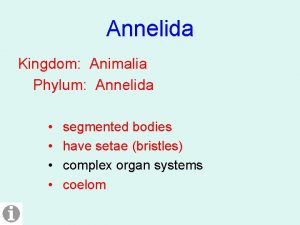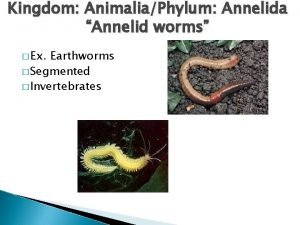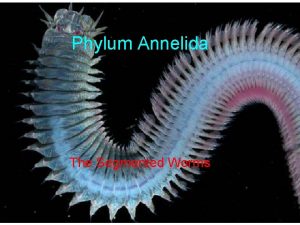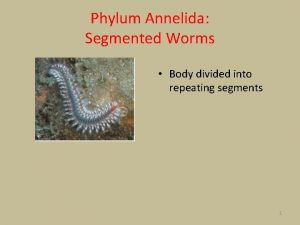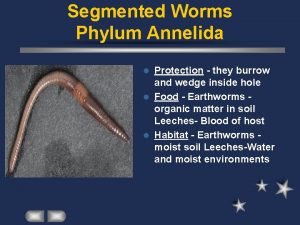ANNELIDA THE SEGMENTED WORMS Core Course No ZOOA











































- Slides: 43

ANNELIDA THE SEGMENTED WORMS Core Course No. ZOOA – P 1 T, Group-A, Topic No. 2


BAUPLAN AND FUNCTION Ø Bilaterally symmetric, triploblastic, true coelomate animals. Ø Body vermiform , elongated, divided into three regions, anteriormost protostomium (bears brain and sensory organs), posteriormost pygidium (bears anus)and intermediate metamerically segmented trunk Ø They locomote by epidermal chitinous bristles chaetae (absent in leeches and few polychaetes) Ø Gut straight and tubular , from anterior mouth till posterior anus, digestion extracellular. Ø Respire mostly by moist body surface, but through gills in some tube dwellers (Arenicola sp. , Cirratulus sp. ). Respiratory pigments such as Haemoglobin, chlorocruorins and haemerythrin are found in blood plasma and coelomocytes. Ø Closed vascular system comrised of contractile dorsal vessels(in few modified into heart), ventral vessels and intermediate capilary plexus. Ø Nervous system is ladder like , comprised of brain and double ventral nerve cords (segmentally arranged ganglia and lateral projections). Ø Excrete by means of filtration nephridia, i. e segmentally coiled tubes known as metanephridia (rarely protonephridia) Ø Sexes separate or united, develoment direct (Oligochaeta, Hirudinea) or indirect through trochohore larva (polychaeta) Ø They inhabit Aquatic (marine, freshwater) and terrestrial habitats.

Annelid Body Plan chaetae


Annelid Characteristics 6 � Defining Characteristics One or more pairs of chitinous Chetae � The phylum includes polychaetes, earthworms, leeches, and vestimentiferans l True segmented worms – Metameric segmentation Phylum Annelida

Body Structure 7 � The body is a tube within a tube l The coelom is important to annelids for: l The epidermis is what secretes the tough cuticle Phylum Annelida

Systems �Integument epidermis is one cell layer with mucous gland that secrete a moist cuticle. �Skeletal -hydrostatic (using coelom) �Muscle longitudinal and circular muscles Each segments muscles are independent of the other segments. �Digestive complete, complex, with absorption and digestive glands and excretory cells.

Systems (continue) � Excretory a pair of metanephridia per segment. � Respiratory –generally through skin, some through parapodia; tubeworms have gills. � Circulatory closed system, use hemoglobin as oxygen carrier. � Nervous dorsal brain; ventral, double, solid nerve cord, with segmental ganglia in each segment. � Endocrine hormones secreted by nervous system. � Reproductive Dioecious in Polychaeta; no special organs, posterior end becomes gonads. Monoecious in Oligochaeta and Hirudinea; Clitellium.

Locomotion 10 � On each side of the animal is a parapod (parapodia) consisting of fleshly lobes, which are supported by chitinous rods � Each parapod have chetae, which can be sharp (protection), and aid in locomotion Phylum Annelida

Digestive System 12 Phylum Annelida

Circulatory System 13 �Blood flows entirely in closed vessels �Some spp. have hearts �Blood contains hemoglobin, which increases oxygen carrying ability Phylum Annelida

Excretory & Nervous System 14 Nervous system Phylum Annelida



Reproduction 17 � Sexes are usually separate with gonads occurring in each segment Some species have gonad specific segments � Breeding is usually seasonal (spring or fall) � As gametes mature they fill the coelom and are released by the nephridia � Fertilization can be internal or external � Trochophore larvae develop, which are remarkably similar to the Molluscs Phylum Annelida

Phylum Annelida � Ancestral Traits Spirobranchus giganteus Christmas tree worm Coelomate Lophotrochozoan- non-molting protostomes Protostome Closed circulatory system Cephalization � Derived Traits Segmentation � Metamerism � Septa Setae � Bristles Myelinated neurons ~ 40 K species of annelids

Classification BARNES, 1994


Class Polychaeta (Poly= many; Chaeta=bristles) Ø Elongated, metamerically segmented body, antrior head is comprised of prostomium (bearing eyes, antennae and palps) and peristomium (bearing cirri). Ø Each trunk segment typically bears a pair of bilateral fleshy paddle like outgrowths, Parapodia (fecilitates locomotion and gas exchange) bearing bundles of chaetae. Ø Parapodia are biramous (two branches), dorsal notopodium and vental neuropodium both lobes bearing its own cluster of chaetae. Both lobes are supported internally by acicula (singular aciculum), which are chitinous skeletalrods Ø Respiration generally by means of body surface, in some forms specialized unprotected gills are present, which are modified parapodial outgrowth. Ø Excretion, occasionally by protonephridia (forms lack or have reduced hemal system), but mainly through metanephridia. Ø Digestive system with an eversible buccal region and protrusible pharynx. Ø Reproduce sexually, sexes separate (gonochoric), exhibit epitoky (synchronous maturation and mating), fertilization external. Ø Develoment indirect, though Trochophore larval stage. Ø Exclusively marine, Clitellum absent Example: Aphrodite (sea mouse), Nereis (rag worms), Chaetopterus (paddle worms), Arenicola (lug worms), Sabella (fanworms), Glycera (tounge worms) etc.


Class Oligochaeta (Oligo= few; Chaeta=bristles) Ø Streamlined body, well developed segmentation, four bundles of chaetae per segment, the small prostomium and pygidium devoid of appendages. Ø They possess a Clitellum (reproductive structure), a thick glandular epidermal covering, encircling and thus forming a girdle around a series of anterior segments. Ø Their head is indistinct, without eyes and tentacles and cirri, Ø The locomote and burrow by means of body wall musculature, cheatae are less distributed along the body, parapodia absent. Ø Respiration generally by means of moist body surface, except few posessing true gills. Ø They have various numbers (one to five pairs) of pulsatile muscular hearts (modified circumenteric vessels), Excretion by metanephridial system. Ø Reproduce sexually, sexes united (hermahrodite), exhibit cross fertilization (interchange of sperm between copulating pairs), fertilization external. Ø Develoment direct. Within cocoon secreted by clitellum. Ø Most are fresh water or terrestrial inhabitants, a few are marine. Example: Pheretima, Lumbriculus, Tubifex, Nais, Branchiura, Megascolex,


Class Hirudinea Ø Elongated body, dorsoventrally flatenned and tapered anteriorly, bearing small anterior sucker and large, disc shaped posterior sucker. Ø Body made up of 33 segments, head is composed of 6 segments (reduced prostomium and next 5)bears several ocelli (dorsally) and ventrally anterior sucker (surrounding mouth), Trunk is composed of 21 segments (6 -26), followed by Posterior sucker composed of 7 segments (27 -33), anus located dorsally on (or near) the last trunk segment Ø Trunk is divided into preclitellar region, clitellum spanning 3 segments (9 -11) and conspicuous only during reproductive period, and the last postclitellar region, Ø Coelom is reduced due to expansion of overlying connective tissue compartment, also the coelomic cavity is continuous and uninterrupted (no septa and mesenteries) Ø Excrete by means of 10 -17 pairs of metanehridia (1 pair per segment), located in the middle third of the body. Ø Locomote by inchworm like crawling and swimming, they also burrow, fecilitated by body wall musculature and both the suckers. Ø They are Hermaphrodite (cross fertilize), reproductive structures are restricted to anterior few segments, fertilization internal, development direct and occurs inside cocoons secreted by clitellum. Ø colonize marine, freshwater and terrestrial habitats. Ø Example: Hirudo, Hirudinaria (cattle leech), Aulostoma (horse leech), Glossiphonia, Piscicola, Branchiobdella,




Earthworm





Metamerism

Ø The phenomena where individuals body is made up of a number of identical units known as segments/metameres, each of which bears similar internal and external components and are repeated one after the another. Occurrence i. iii. Annelid and arthropod line Chordate line Cestode line Features i. iii. Only confined to trunk Identical units bears segmental (separated) and integrating component (continuous) Co ordination between segmental and integrating components Origin of Metamerism ü Gonocoel theory ü Cyclomerism theory ü Corm theory Types

Advantages of Metamerism ü Efficient energetics during locomotion ü Scope for tagmosis by means of i. Restriction ii. Divergence iii. Fusion

ETC







Sources Ø E. E. Ruppert et al. , Invertebrate Zoology , 7 th Edition, Cengage Learning, 2004 Ø R. C. Brusca and G. J. Brusca. , Invertebrates, 2 nd Edition, Sinaur Associates, 2003
 The characteristics of annelids
The characteristics of annelids Chapter 27 mollusks and segmented worms answer key
Chapter 27 mollusks and segmented worms answer key Annelida
Annelida Hirudenia
Hirudenia Segmented worms definition
Segmented worms definition Section 27-1 flatworms
Section 27-1 flatworms What are some invertebrates
What are some invertebrates Symmetry of worms
Symmetry of worms Are worms mollusks
Are worms mollusks The segmental arrangement of body parts
The segmental arrangement of body parts Is platyhelminthes segmented
Is platyhelminthes segmented Class turbellaria characteristics
Class turbellaria characteristics Chapter 25 section 3 mollusks
Chapter 25 section 3 mollusks Flatworms phylum
Flatworms phylum Unsegmented worms examples
Unsegmented worms examples Tư thế worm breton là gì
Tư thế worm breton là gì Basic layers of the earth
Basic layers of the earth Purpose of paradox
Purpose of paradox Inner core and outer core
Inner core and outer core Crust mantle core
Crust mantle core Gpa.com
Gpa.com Course number and title
Course number and title Course interne course externe
Course interne course externe English bond t junction elevation
English bond t junction elevation Price is right recap
Price is right recap Segmented lru
Segmented lru Jointed legs
Jointed legs Segmented least squares dynamic programming
Segmented least squares dynamic programming Are arthropods coelomates
Are arthropods coelomates Jointed appendages definition biology
Jointed appendages definition biology Segmented bodies and jointed legs
Segmented bodies and jointed legs Principles of marketing chapter 11
Principles of marketing chapter 11 Bases for market segmentation
Bases for market segmentation When new port shipping uses segmented marketing
When new port shipping uses segmented marketing Consist of your most important targeted or segmented groups
Consist of your most important targeted or segmented groups Segmentation de niche
Segmentation de niche Segmentation arthropods
Segmentation arthropods Segmented pricing
Segmented pricing Price adaptation strategies
Price adaptation strategies Segmented target building
Segmented target building You like seafood and i do
You like seafood and i do Features of insects
Features of insects Paging in non contiguous memory allocation
Paging in non contiguous memory allocation A blue segmented circle on a sectional chart
A blue segmented circle on a sectional chart
